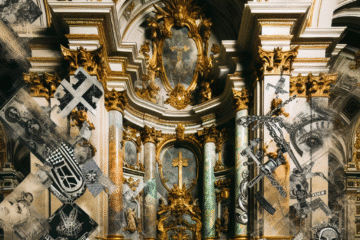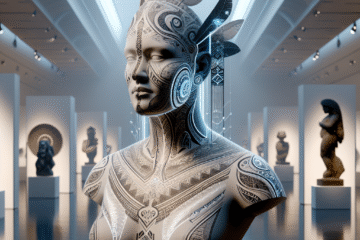
Image title: The Birth of the Virgin
Medium: Tempera and oil on wood
Date: 1467
Source:
The Met Collection
“
I can, therefore I am.
”
— Simone Weil
‘I Paint Therefore I Am’: Cartesian Philosophy in Abstract Expressionism
Introduction: A Brush with Philosophy
The phrase “I think, therefore I am,” coined by 17th-century French philosopher René Descartes, revolutionized the way we understand consciousness, selfhood, and existence. Three centuries later, a surprising artistic movement would echo Descartes’ foundational philosophy—not through words, but through paint. Abstract Expressionism, a groundbreaking mid-20th-century art movement, became the visual language of self-awareness, inner necessity, and radical subjectivity. In a postwar world wrestling with trauma, existential uncertainty, and the rise of psychoanalysis, painters like Jackson Pollock, Mark Rothko, and Lee Krasner sought not to represent the world as it was, but to declare their being through the act of painting itself.
Abstract Expressionism was not born in a vacuum. It was a cultural phenomenon that emerged from a fertile confluence of European philosophy, American innovation, and global turmoil. This article unpacks how the Cartesian idea of the self as the primary truth resonated through canvas and color, morphing philosophy into action across five pivotal art-historical transformations.
1. From Enlightenment to Existentialism: Philosophy as Background Radiation
The Cartesian legacy in Western thought formed the skeleton of Enlightenment rationalism, where the self was both observer and participant of reality. But by the 20th century, especially following the harrowing disruptions of two world wars, confidence in reason had eroded. Existentialist thinkers like Jean-Paul Sartre and Martin Heidegger turned the spotlight inward, emphasizing existence, freedom, and authenticity. These ideas trickled into the intellectual bloodstream of modern art communities, particularly among American artists absorbing European émigré intellects fleeing fascism. The focus shifted from objective observation to subjective truth—art no longer needed to depict the world; it became sufficient for it to declare the inner state of its creator.
Abstract Expressionism arose out of this philosophical ferment. To these modern painters, the process of creating—gesture, immediacy, action—became a mode of existential affirmation. As Descartes used thought to assert his existence, Abstract Expressionists used paint.
2. The Canvas as Arena: Action Painting’s Radical Gesture
In Harold Rosenberg’s now-famous formulation, the canvas was not a picture but “an arena in which to act.” His term “Action Painting” captured the kinetic dynamism of artists like Jackson Pollock, who famously laid his canvases on the ground and danced around them, flinging and dripping enamel industrial paints with balletic abandon. This technique wasn’t only aesthetic but metaphysical—it was a record of conscious, dynamic being. Each splash became a marker of existence affirmed in time and space.
Pollock’s 1950 work Autumn Rhythm is frequently cited as the epitome of this mode. But beyond spectacle, it underscores the Cartesian echo: each gesture, unpremeditated yet intentional, declares, “I am painting, therefore I am.” In rejecting formal narrative and traditional composition, Action Painting positioned the artist’s raw subjectivity as the focal point of both the process and the final artwork.
3. Color Fields and the Emotional Self
Another wing of Abstract Expressionism explored the inner life through color. Artists like Mark Rothko, Barnett Newman, and Clyfford Still created vast color fields that invited viewers into an introspective space that mirrored the artists’ own states of consciousness. Rothko, with his blurred rectangular forms stacked vertically in somber hues, intended for his paintings to be felt rather than seen. These canvases were not about abstract forms—they were embodiments of tragedy, ecstasy, and the sublimity of existence.
This meditative approach was akin to a philosophical inquiry into the self. Where Descartes dissected thought, Rothko and his peers excavated feeling. The absence of figuration heightened the demand that each viewer bring their own consciousness to the experience—mirroring the same existential transaction that occurred in the painter’s studio. Self-awareness became a mutually participatory act between creator and observer.
4. The Influence of Psychoanalysis and Social Unrest
Philosophy was not the sole wellspring of introspection feeding the Abstract Expressionists. The era’s rise of psychoanalysis, particularly the work of Freud and Jung, further emphasized unconscious drives, dreams, and archetypes. These insights reinforced the movement’s inward turn. By delving into subconscious material, artists explored realms of the self inaccessible to reason alone—a Cartesian introspection passing through a Freudian mirror.
Meanwhile, the postwar cultural climate—Red Scare anxiety, atomic dread, the looming Cold War—amplified the collective need for personal authenticity. Abstract Expressionism emerged not just as an art form, but as an ideology, a mode of being in resistance to the dehumanizing forces of modernity. The solitude of the painter before the canvas mirrored civil disconnection, making the painted gesture both personal and political.
5. Legacy and Echoes in Contemporary Art
The influence of Abstract Expressionism, and its philosophical echoes, continues to reverberate through contemporary art. Performance art, conceptualism, and even digital mediums today reflect a similar concern with interiority, presence, and process. Artists like Marina Abramović use endurance and action to investigate consciousness, while others, like Julie Mehretu, integrate mapping, mark-making, and architectural reference in pursuit of a self-aware visual language.
Technological innovation has complicated these inquiries—where once the hand-drawn mark was proof of presence, now algorithms and AI question what authorship even means. Yet the Cartesian itch remains: in every act of digital creation, the artist asserts, “I code, therefore I am.” Like Rothko and Pollock before them, these creators continue the long tradition of using the act of making as ontological affirmation.
Conclusion: The Brushstroke as Witness to Being
Abstract Expressionism’s bold rejection of representation was not just a stylistic rebellion—it was philosophical drama painted large. These artists did not seek to imitate reality but to proclaim it through their own presence. In doing so, they translated the Cartesian cogito into a creative credo: the act of painting—not the subject depicted—was how one proved one’s existence.
In a world still struggling with questions of identity, consciousness, and authenticity, Abstract Expressionism’s cry resounds: “I paint, therefore I am.”
Image description:
Digital drawing emulating action painting – own work. Somewhat similar to Jackson Pollock
License:
Public domain
Source:
Wikimedia Commons
Useful links:


